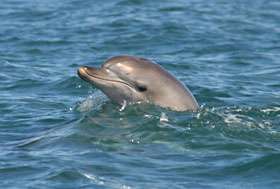Environment shapes dolphin noises

Dolphins appear to change their vocalisations depending on their physical and social environments and level of human interaction, new research shows.
University of Queensland student Melinda Rekdahl has studied dolphin behaviour and communication for her Honours degree with the School of Integrative Biology.
Her results are the first to show that physical and social environments can alter dolphin communication during different activities such as feeding.
Miss Rekdahl studied about 120 dolphins from groups of wild dolphins in Moreton Bay, captive dolphins at Seaworld and provisioned (wild but handfed once a day) at Tangalooma Wild Dolphin Resort.
“Captive and provisioned dolphins whistled more than the wild dolphins while feeding with captive dolphins showing the highest rate of whistles,” Miss Rekdahl said.
“Feeding was the behaviour most influenced by humans in the captive and provisioned environment.
“Human interaction through the provisioned feeding environment may lead to different vocalisations being used.”
Miss Rekdahl spent two weeks with each dolphin group and recorded hundreds of hours of dolphin noises such as burst pulses and clicks and 10 hours' of whistles.
She recorded the rates, types and frequency of whistles amongst the groups during feeding, socialising and milling.
Dolphin whistles and pulses are mainly used for social communication while their eco clicks are used for feeding and navigation.
Miss Rekdahl will present her dolphin research at the International Marine Mammal Conference later this month in Cape Town.
Source: University of Queensland
















